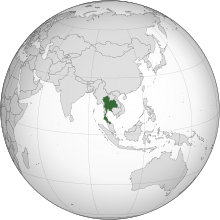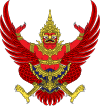Squatting in Thailand



Squatting—the act of unlawfully occupying land or property—is prevalent in Thailand. The 1975 Agricultural Land Reform Act aimed to redistribute land to poor people (including squatters) under the Sor Por Kor program and as of 2019, 36 million rai or 5.8 million hectares of land had been assigned. In 2015, Bangkok had over 2 million squatters out of a population of around 10 million.
Legal[]
A squatter in Thailand is someone who unlawfully occupies land or property. Adverse possession requires a ten year continuous occupation under Section 1382 of the Civil and Commercial Code.[1] The customary law regarding possession of land is called "latti-thamniam", in which all land ultimately belonged to the king and people could farm land, thus gaining de facto rights. In 1901, King Rama V (also known as Chulalongkorn) introduced a system of modern land rights based on ownership which led to general confusion.[2] A 1936 law aimed to clarify matters and the 1954 Land Code regulated land ownership, stating the maximum one person could own was 1 rai or 0.16 hectares.[2][3] It was then cancelled by Prime Minister of Thailand Sarit Thanarat with Proclamation 49 after he had seized power. The Agricultural Land Reform Act was introduced in 1975 and was intended to redistribute state land, including to those already squatting on it.[3] The program was known as Sor Por Kor.[4] In 1981, farmers occupying land in forest reserves were offered land rights for up to 5 rai or 2.4 hectares.[5]
History[]
The capital Bangkok (or Krung Thep Maha Nakhon) had an estimated 500,000 squatters in the 1960s, making up 24 per cent of its population.[6] In the 1970s and 1980s, the city authorities negotiated with some squatters to develop the land they occupied without displacing them. Deals were made with 10,000 squatters.[7] By 2014, there were over 2 million squatters out of a population of around 10 million.[6]
A survey of slums across the country noted in 2000 that most slums were rented not squatted. There were 125 squatted informal settlements in Bangkok, 181 in the Bangkok Metropolitan Region, 1 in Nakhon Pathom, 10 in Nonthaburi, 28 in Pathum Thani, 13 in Samut Prakan, 4 in Samut Sakhon and 112 in other cities.[8] One of the largest slums in Bangkok is in the Khlong Toei District, where there are 80,000 to 100,000 people, including squatters.[9] It was surveyed in 1971.[8]
In 1987, at least 5.3 million hectares of land (that is to say 20 per cent of all land designated as forest) was being farmed by a million rural squatters. Even if the families had been living on the land for over ten years, they were still termed squatters, yet evictions were rare.[10] The Hmong people moved into northern Thailand at the end of the 19th-century. The Thai government has attempted to resettle them into villages, aiming to stop deforestation and the production of opium.[11] In 1986, 5,000 people were evicted from Khlong Hai and the following year over 1,000 Akha, Lahu and Lisu peoples were deported to Burma.[11]
Sor Por Kor[]
Under the Sor Por Kor program, the government intended to distribute 40 million rai or 6.4 million hectares of land to poor farmers, some of them squatters. By 2019, 36 million rai or 5.8 million hectares had been assigned and 800,000 farmers were still waiting to receive land rights. The Ministry of Agriculture and Cooperatives announced it would be investigating cases in which farmers had illegally sold their land or were not qualified to receive it.[4]
References[]
- ^ "Define 'Squatter' in Legal Terms". Thailand Law Online. Retrieved 13 April 2021.
- ^ a b Yano, Toru (1968). "Land Tenure in Thailand". Asian Survey. 8 (10): 853–863. doi:10.2307/2642084. ISSN 0004-4687.
- ^ a b Suehiro, Akira (1981). "LAND REFORM IN THAILAND. The Concept and Background of the Agricultural Land Reform Act of 1975". The Developing Economies. 19 (4): 314–347. doi:10.1111/j.1746-1049.1981.tb00700.x.
- ^ a b Staff writer (9 September 2019). "Govt gets tough on plot squatters". Bangkok Post. Retrieved 13 April 2021.
- ^ Rigg, Jonathan; Salamanca, Albert; Phongsiri, Monchai; Sripun, Mattara (2018). "More farmers, less farming? Understanding the truncated agrarian transition in Thailand". World Development. 107: 327–337. doi:10.1016/j.worlddev.2018.03.008.
- ^ a b Aldrich, Brian C. (2016). "Winning their place in the city: Squatters in Southeast Asian cities". Habitat International. 53: 495–501. doi:10.1016/j.habitatint.2015.12.001.
- ^ "Urban Regeneration". World Bank. Retrieved 13 April 2021.
- ^ a b PORNCHOKCHAI, SOPON. City Report Bangkok (PDF). HABITAT.
- ^ Swift, Richard (2 January 2006). "The lease on life". New Internationalist. Retrieved 13 April 2021.
- ^ Feder, Gershon (1987). "Land ownership security and farm productivity: Evidence from Thailand". Journal of Development Studies. 24 (1): 16–30. doi:10.1080/00220388708422052.
- ^ a b Tapp, Nicholas. "Squatters or Refugees: Development and the Hmong". In Wijeyewardene, Gehan (ed.). Ethnic Groups Across National Boundaries in Mainland Southeast Asia. Institute of Southeast Asian Studies. pp. 149–172. ISBN 978-981-3035-57-7.
- Squatting by country
- Thai law
